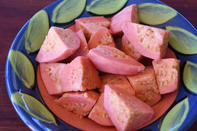The guava is a tree or shrub, which generally grows quite slowly. Cultivated trees are usually pruned to a size of 2 to 3 m in height, but if left unpruned some varieties can grow up to 8 m.

The trees develop fruit from the second year of cultivation and can continue to bear for up to 40 years. Trees flower in Spring and while bees are the main pollinators, self-pollination also occurs.
The mature trees of most varieties are reasonably frost resistant and can survive drops in temperature to -4°C but temperatures below freezing point are likely to kill or badly damage younger trees. Very hot temperatures during the flowering and fruiting stage can be harmful to the crop.
Guava fruits are round or oval and, depending on the variety of the fruit, are typically 6 to 12 cm in diameter. The fruit has an edible skin, which is usually rough. As the fruit ripens, the skin will change colour from green to a yellow-green or pinkish yellow colour. The fruit flesh is either deep pink (red guavas) or off-white (white guavas) and the fruit pulp contains numerous small, hard seeds.
The number and size of the seeds vary depending on the variety. Guava fruit has a distinctive, strong, musky fragrance.
Nutritional Value
Guavas are a good source of vitamins A, B, and C and iron. They have an extremely high, 257% of the Daily Value, of Vitamin C content, which is higher than that of a pawpaw’s and citrus fruits.
The Vitamin C content remains remarkably stable when the fruit is canned or dried. Whole, fresh guavas are a very good source of B-carotene and iron and an average source of calcium and potassium. They are also a good source of dietary fibre and contain moderate levels of folic acid.
Varieties
The South African guava industry is primarily based on a local cultivar called Fan Retief, named after the founder of this industry. This variety has a vivid salmon pink flesh, and derives from the original guavas, brought to the Cape via Madeira, by the early Dutch settlers in the seventeenth century.
The pink-fleshed Fan Retief variety accounts for 90% of commercial plantings. The particular salmon pink shade of the Fan Retief guava variety is highly prized by international juice producers.
In 1994, the Agricultural Research Council’s (ARC) Institute for Tropical and Subtropical Crops (ITSC) released TSG2 an improved variety. This more disease resistant variety has fewer pips and is significantly larger than the Fan Retief fruit. However, it did not gain popularity in the Western Cape, due to the higher crop yields achieved by the traditional Fan Retief variety.
Season
Guavas are harvested during winter months and in South Africa, the harvest runs from May until September or October.